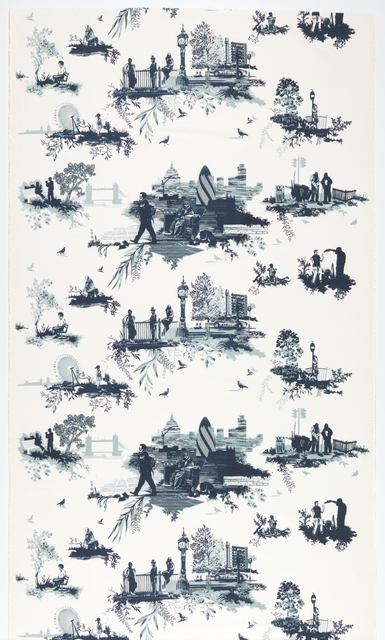When paging through interior design magazines, classic toiles of red or blue on white are used to create a relaxed, yet refined country house look. A room decorated using toile, for a wallpapered accent wall or for a carefully upholstered suite of sofa and chairs, often projects a lady-like atmosphere and is intentionally nostalgic for a time past. The toiles that we are familiar with today originated in the second half of the eighteenth century in France.[1] During this period it was a popular pastime for the aristocracy to recreate what they imagined to be the quaint pleasures of peasant life. Watteau and Fragonard capture this recreational trend in their paintings of romantic and blissful scenes of well dressed ladies and gentlemen lounging among the bounty of nature and relishing the simple joy of gliding on a swing. The popularity of this eighteenth-century version of “slumming” inspired textile manufactures to capitalize on the aristocracy’s fascination with country folk and the perceived recreations of outdoor laborers.[2] The toiles that were developed during this period still remain popular today and continue to depict the idealized version of eighteenth-century farm and peasant living. Instead of showing a woman sweating and dishevled as she milks a cow, the cow stands behind the woman as she plays with her child in a dress that shows little wear and tear. In most scenarios the people illustrated aren’t working, but can be identified as peasants by what they’re wearing, straw hats and unembellished clothes with bare feet and exposed lower legs. Other toiles were patterned with what was understood during that period as Asian motifs, pagodas and men wearing jackets with mandarin collars and frog closures. It is important to remember that toiles captured romanticized images of peasants and exotic lands that were based on fantasy.
Knowing that traditional toiles often depict projections and idealizations of farm workers and foreign lands allows for a deeper appreciation of London Toile. Designed by Timorous Beasties, the Scottish team of Alistair MacAuley and Paul Simmons who met during their studies at the Glasgow School of Art, London Toile challenges and plays with the notion of traditional toiles. Instead of the bucolic scenes of happy peasants sitting in the grass under a tree, Timorous Beasties selected raw scenes that counter the notion of fantasy with less than glamorous images of everyday scenarios in a gritty urban landscape including: a man with a backpack talking on a cell phone passing a homeless man with a cart and a dog, two men who are collecting garbage or cleaning the street near a traffic light, a person being held up at gunpoint, and three men standing near some railing with a police car and housing project in the background. Rather than signifiers of open country landscapes like trees, dirt paths, and rustic wooden fences, London Toile uses architectural landmarks to help the viewer identify the city: the London Eye (Millennium Wheel), Tower Bridge, 30 St. Mary Axe (informally known as “The Gherkin”), and St. Paul’s Cathedral. The blending of old and new buildings from the London landscape further bring the design into the present day, making the design contemporary and relatable. In an article where Simmons discusses their toile collection (which now includes toiles for Glasgow and New York City) he states, “I love the idea of an upper middle-class fabric depicting the underbelly of urban chaos.”[3] Although London Toile is thematically the antithesis of traditional toile using raw and realistic imagery that is seen in the present day, there is one toile characteristic that Timorous Beasties have not changed: the format and presentation of their images. From afar, London Toile looks like any other.
If a traditional toile was replaced by the Timorous Beasties’ design in an interior design magazine spread, the switch would likely go unnoticed. However, if one takes the time to examine the images presented, it is only then that the, perhaps too realistic, scenes of urban life can be recognized. This quality – from afar giving off the feel and look of traditional toile and up close unsettling the viewer with the unexpected – is what makes London Toile a clever reimagining of a traditional textile that also serves as commentary on present-day culture. London Toile hopes to engage the viewer, challenging our dwindling attention spans. It toys with the person who quickly processes and moves on, not taking the time to look, inspect, or appreciate detail. In fact, London Toile has been purchased in stores and then abruptly returned after customers realized that unconventional scenes are shown.[4] Timorous Beasties have an unexpected and refreshing approach to a textile type that is romanticized through associations with aristocratic country houses and fantasy. This approach reminds us and invites us to take a closer look at our surroundings.
Megan Elevado is a Brooklyn native who is fascinated by East German and Soviet culture and design. She earned her BA at New York University and completed her MA in the History of Decorative Arts and Design at Parsons The New School for Design in May 2013.
[1] Sarah Grant and Christine Smith, Toiles de Jouy: French Printed Cottons, 1760-1830(London: V&A Publishing, 2010), 42.
[2] Ibid.
[3] Lutyens, Dominic. “Observer Magazine: TOILE AND TROUBLE: A Wino Boozing on a Bench, a Junkie Shooting Up… Hardly the Usual Subjects of Expensive Wallpaper. Dominic Lutyens on the Subversive Designs of the Timorous Beasties. Photographs Jefferson Smith.” The Observer, March 20, 2005.http://search.proquest.com/docview/250337991?accountid=12261.
[4] Stuart Jeffries, “The Writhing on the Wall,” The Guardian, February, 7, 2007. http://www.guardian.co.uk/artanddesign/2007/feb/08/design.britishidentity.
